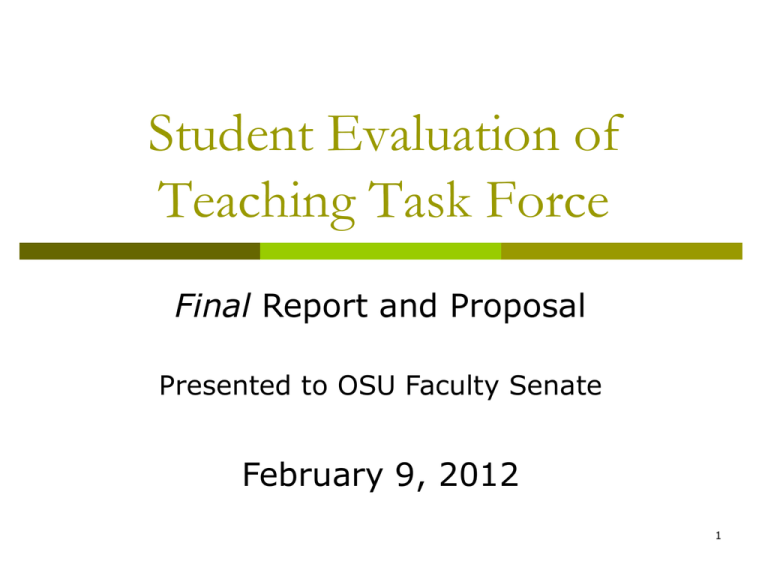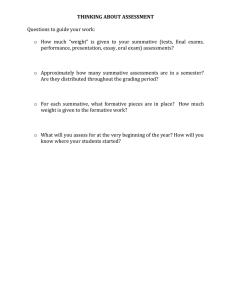Student Evaluation of Teaching (SET) Task Force PowerPoint
advertisement

Student Evaluation of Teaching Task Force Final Report and Proposal Presented to OSU Faculty Senate February 9, 2012 1 Why Conduct SET? Improve both teaching and learning Provide students a voice in assessment of instruction/faculty Meet state OAR 580-021-0135 (3) requirements, which do not specify the current format: “Specific provision shall be made for appropriate student input into the data accumulated as the basis for reappointment, promotion, and tenure decisions, and for post-tenure review. Sources of such input shall include, but need not be limited to, solicitation of student comments, student evaluations of instructors and opportunities for participation by students in personnel committee deliberations.” 2 SET Role in Faculty Review 3 Charge for SET Task Force Evaluate current SET system Recommend changes aimed at the improvement of teaching 4 Additional Items to be Considered Survey students Identify inherent biases Identify mitigating factors (years of teaching experience, size of class, type of class, level of class, etc.) Identify links between SET ratings and Learning Outcomes Assessment 5 Problems with Current SET Form Summative feedback comes too late Require value constructs (excellent, etc.), which tend to vary between students Global/overall ratings (#1 and #2) ignore complexity of teaching May be influenced by situational factors Inherent bias (diversity and legal implications) Reduces correlation with learning Inconsistent use in faculty evaluation Discourages innovation Creates perverse incentives 6 Task Force’s Goals for Assessment Tool Focus on improving teaching Focus on elements that affect student learning Employ a formative approach Allow for evaluation of diverse teaching methods and philosophies Provide a flexible system that faculty can adapt to their course 7 An Assessment Tool Should . . . Permit feedback during the term, when it’s helpful to the class Allow instructors to choose items Limit access to the data to discourage misleading and invidious comparisons Address factors that affect learning (e.g., course design, classroom environment, materials) 8 What the Task Force Learned From students: Expect confidentiality Like the idea of formative feedback Don’t know why student evaluations of teaching are conducted or how information is used From administrators: Express a need for summative information 9 What the Task Force Learned From faculty: Worry about inconsistent use of scores in current system Have concerns about variability in value constructs Doubt the validity of a single instrument for such a wide range of class types Appreciate customization of proposed feedback 10 Proposed Formative Categories Instructional design Engaging learning Objectives Exams and assignments Materials and resources Learning activities Classroom environment Extended engagement Instructional assessment Fairness Helpfulness Opportunity to demonstrate knowledge 11 Proposed Formative Categories Self-reported course impact on the student Motivation Cognitive expansion Skill development Alternative and supplemental teaching/learning environment Laboratory and discussion Clinical Seminars Team teaching Field trips Studio 12 Play movie now 13 Options for Current Items #1 & #2 Summative in nature Would not be mandated Current Item Available Alternative 1. The course as a whole was… (poor, fair, … excellent) I would recommend this course. (strongly agree, agree, disagree, strongly disagree)* 2. The instructor’s contribution to the course was… I would recommend this teacher to a fellow student.** * Formative item is under >Self-reported impact on the student>Motivation>item #1 ** Formative item is under >Self-reported impact on the student>Motivation>item #14 14 Proposal Change to a formative assessment tool Create a fully customizable instrument Rename “Student Assessment of Teaching” (SAT) Deploy online Allow teachers control of items used, timing/frequency, and access to data Report which items were used and when to administrators, but not results Include discussion of how faculty respond to SAT data to improve teaching in Periodic Review of Faculty (PROF) process 15 The SET Task Force Membership Members (2009-present) Members (2010-present) Henri Jansen (Science) William Loges (Liberal Arts) Deborah Pence, Chair (Engineering) Juan Trujillo (Liberal Arts) Beth Valentine (Veterinary Medicine) Kenneth Winograd (Education) Christopher Wolsko (Cascades Campus) LJ Duey, Undergraduate student (University Exploratory Studies) Mario E. Magaña (Engineering) Gita N. Ramaswamy (Academic Programs, Assessment and Accreditation) Marc Schure, Graduate student (Public Health) Members (2009-2010 and 2010-2011) Joshua Keady, Undergraduate student (Business) Susie Leslie (Academic Planning and Assessment) Travis Margoni, Graduate student (Liberal Arts) Peter Saunders (Center for Teaching and Learning) Nancy Staton Barbour, Graduate student (Women Studies) 16 Acknowledgements Faculty Senate Presidents and Executive Committees (2009-2010, 2010-2011, 2011-2012) Faculty Senate Promotion and Tenure Committee (2010-2011) CollegeNET Vickie Nunnemaker (Faculty Senate) Catherine Williams (Enterprise Computing Services) Angelo Gomez & Anne Gillies (Office of Equity and Inclusion) Sue Helback (College of Education) Faculty, staff and students for their input 17
